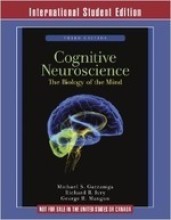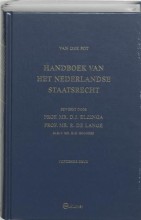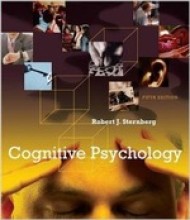Samenvatting: Cognitive Neuroscience: The Biology Of The Mind | 9780393111361 | Michael S Gazzaniga, et al
- Deze + 400k samenvattingen
- Een unieke studie- en oefentool
- Nooit meer iets twee keer studeren
- Haal de cijfers waar je op hoopt
- 100% zeker alles onthouden
Lees hier de samenvatting en de meest belangrijke oefenvragen van Cognitive Neuroscience: The biology of the mind | 9780393111361 | Michael S. Gazzaniga, Richard B. Ivry, George R. Mangun ; with Megan S. Steven.
-
1 A Brief History of Cognitive Neuroscience
Dit is een preview. Er zijn 28 andere flashcards beschikbaar voor hoofdstuk 1
Laat hier meer flashcards zien -
Wat blijft intact en wat niet bij split-brain patienten wat betreft interpretaties?
Verbale intelligentie en probleemoplossingsvaardigheden blijven relatief intact, maar de mogelijkheid om vrij op te roepen (free recall) niet. Dit geldt voor de linker hemisfeer, bij de rechter hemisfeer is dit wel beschadigd. -
Wat is 'neuronal conduction'?
Neuronal conduction is het proces hoe het brein informatie overbrengt. -
Het geheugen omvat drie belangrijke aspecten:
de opslag, het vasthouden of bewaren en het terugzoeken van informatie. -
Wordt de emotionele staat van mensen verstoord door split-brain operaties?
Nee, want de transfer van emotionele staat vindt subcorticaal plaats. -
Uit welke drie onderdelen komt het proces van cognitie (weten) uit voort?
Het proces van cognitie (weten) komt voort uit:- Bewustzijn
- Perceptie
- Redeneren
-
In welke verhouding pompt de natriumkalium-pomp?
3 Na naar buiten en 2 K naar binnen -
Wat zijn de limitaties van lateraliteitsonderzoek zoals 'dichotic listening task'?
Bias in publiceren, kleine en inconsistente resultaten, interpretatie is problematisch. -
Welke hersengebieden horen bij welk soort geheugen?
Amygdala - angstcerebellum - trial and error gebaseerd op voorspellingsfoutenbasale ganglia - bekrachtiging -
Wat zijn 3 functies van de geplooide cortex?
- Vergroten oppervlak
- Driedimensionale binding tussen neuronen gaat over kleinere afstand
- Verschillende hersengebieden kunnen met elkaar verbonden worden -
Welk gebied is het belangrijkst bij geheugen? En welk belangrijk gebied behoort ook tot deze?
Medial temporal lobe, hippocampus
- Hogere cijfers + sneller leren
- Niets twee keer studeren
- 100% zeker alles onthouden
Onderwerpen gerelateerd aan Samenvatting: Cognitive Neuroscience: The Biology Of The Mind
-
A Brief History of Cognitive Neuroscience - The brain story
-
A Brief History of Cognitive Neuroscience - The psychological story
-
Cellular Mechanisms and Cognition - Cells of the nervous system
-
Cellular Mechanisms and Cognition - Neuronal signaling
-
Transmembrane proteins: Ion Channels and pumps - Ion channels - Gated and Nongated ion channels
-
Cellular Mechanisms and Cognition - Synaptic transmission
-
Neuroanatomy & Development - Neuroanatomy
-
Neuroanatomy & Development - Gross & functional anatomy of nervous system
-
Neuroanatomy & Development - Development of the nervous system
-
Neuroanatomy & Development - Plasticy in the nervous system
-
Neuroanatomy & Development - Key Terms
-
Stenberg- aandacht en bewustzijn
-
Sensation & Perception - Auditory Perception
-
Sensation & Perception - Olfactory perception
-
Sensation & Perception - Gustatory Perception
-
Sensation & Perception - Somatosensory Perception
-
Sensation & Perception - Vision - Deficits in visual perception
-
Sensation & Perception - Multimodal Perception - Synesthesia
-
Object Recognition - Two cortical pathways for visual perception
-
Object Recognition - Computational problems in object recognition
-
Object Recognition - Failures in object recognition
-
Object Recognition - The perception of faces
-
Object Recognition - Two systems for object recognition
-
The Control of Action - Motor structures
-
The Control of Action - Computational Issues in motor control - Representation of movement plans
-
The Control of Action - Physiological analysis of motor pathways
-
Functional analysis of the motor system and movement disorders - Cortical areas - Apraxia
-
Functional analysis of the motor system and movement disorders - Cortical areas - The cortex and the selection of movement
-
Functional analysis of the motor system and movement disorders - Subcortical areas: cerebellum and basal ganglia - Cerebellum
-
Functional analysis of the motor system and movement disorders - Subcortical areas: cerebellum and basal ganglia - Basal ganglia
-
The Control of Action - Take home messages
-
Learning and Memory - Theories of learning and memory
-
Learning and Memory - Memory and brain
-
Learning and Memory - Cellular bases of Learning and Memory
-
Issues in the Cognitive neuroscience of emotion - Dimensions of emotion
-
Emotion - Neural systems in emotional processing
-
Theories of Language - Storage of words and concepts - Neural substrates of the mental lexicon and conceptual knowledge
-
Storage of words and concepts - Perceptual analyses of the linguistic input - Spoken input
-
Theories of Language - Storage of words and concepts - Written input
-
Language - Theories of Language - Lexical integration in discourse
-
Language - Theories of Language - Speech production
-
Language - Neuropsychology of Language and Language Disorders
-
Language - Neurophysiology of Language
-
Language - Take-home messages
-
Hemispheric Specialisation - Principles of cerebral organization
-
Hemispheric Specialisation - How the two hemispheres communicate
-
Hemispheric Specialisation - Hemispheric specialization
-
Hemispheric Specialisation - What brain functions are lateralized?
-
Attention and Consciousness - Theoretical Models of Attention
-
Attention and Consciousness - Neural Mechanisms of Attention and Selective Perception
-
Attention and Consciousness - Neurology and Neuropsychology of Attention
-
Attention and Consciousness - Models of Attention and Awareness
-
Attention and Consciousness - Take-Home Messages
-
Cognitive Control - Subdivisions of the Frontal Lobes
-
Cognitive Control - The Lateral Prefrontal Cortex and Working Memory
-
Cognitive Control - The Prefrontal Cortex and Other Memory Domains
-
Cognitive Control - Component Analysis of the Prefrontal Cortex
-
Cognitive Control - Goal-Oriented Behaviour - Planning and Selecting an Action
-
Cognitive Control - Goal-Oriented Behaviour - Cognitive Control of Goal-Oriented Behavior
-
Cognitive Control - Goal-Oriented Behaviour - Retrieval and Selection of Task-Relevant Information
-
Cognitive Control - Goal-Oriented Behaviour - Task Switching
-
Cognitive Control - Top-Down Cognitive Control
-
Cognitive Control - Ensuring That Goal-Oriented Behaviours Succeed
-
Cognitive Control - Take Home Messages
-
Social Cognition - Self-Perception and Self-Knowledge
-
Social Cognition - Perception of Other People
-
Social Cognition - Convergence in the Perception of Self and Others
-
Social Cognition - Convergence in the perception of self and other - Representations of Social Knowledge
-
Social Cognition - Convergence in the perception of self and other - Using Social Knowledge to Make Decisions
-
Social Cognition - Convergence in the perception of self and other - Neuroeconomics
-
Social Cognition - Social knowledge - Representations of Social Knowledge
-
Social Cognition - Social knowledge - Social Responses
-
Social Cognition - How we predict what other people are going to do (Frith & Frith)
-
Social Cognition - Sociale cognitie bij adolescenten (art. Blakemore en Iacoboni)
-
Brain Research - Frith
-
An integrative model: working Memory
-
Multiple memory Systems
-
Retrieval - Retrieval from short memory - The winner A serial Exhaustive Model, with some qualifications
-
Exploring cognitive psychology - The nature of attention and consciousness

























![Boekhouden geboekstaafd 2 : [theorieboek] Afbeelding van boekomslag](https://app.studysmart.ai/uploads_prod_data/source/ANYx220/49f03a3bf15c5cbe83cd6c76dd7b11aff9172846.jpeg)





